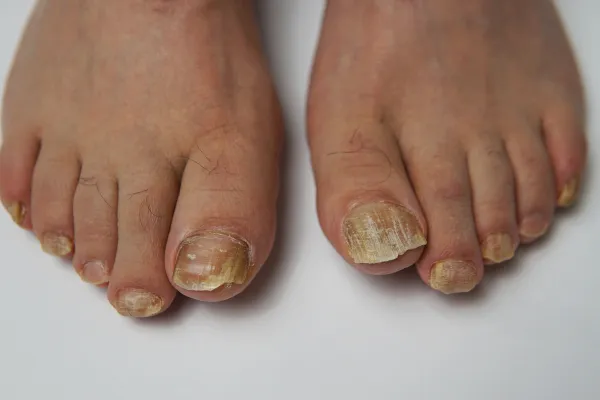
Understanding Fungal Nail Infections: The Causes, Symptoms, and Risk Factors
Fungal nail infections, also known as onychomycosis, are a common yet often misunderstood foot problem. They can cause discomfort, unsightly nails, and potentially lead to more serious foot health issues if left untreated. In this blog post, we’ll dive into the causes, symptoms, and risk factors associated with fungal nail infections and how you can effectively manage or prevent them.
What Are Fungal Nail Infections?
Fungal nail infections occur when fungi, such as dermatophytes, yeasts, or molds, invade the nail bed and surrounding tissue. These infections can affect both fingernails and toenails, but they are most commonly seen in the toenails due to the warm, moist environments in shoes and socks, which are ideal for fungi to thrive.
Fungal nail infections typically start at the edge of the nail and gradually spread toward the center. As the infection progresses, the nail may become thickened, discolored, brittle, and may even begin to separate from the nail bed.
Causes of Fungal Nail Infections
Fungal nail infections are caused by a variety of factors, but they all stem from the presence of fungi in the environment. Here are the most common causes:
1. Fungal Exposure
Fungi are often present in moist, warm environments such as public pools, locker rooms, and communal showers. Walking barefoot in these areas increases your risk of exposure to fungi that can lead to an infection.
2. Weakened Immune System
A weakened immune system makes it harder for the body to fight off infections. Individuals with diabetes, HIV, or those undergoing chemotherapy are at higher risk of developing fungal nail infections due to reduced immunity.
3. Poor Foot Hygiene
Failing to properly care for your feet can contribute to fungal nail infections. If feet are not kept clean and dry, fungi have a better chance of invading the nails. Wearing damp socks or shoes for prolonged periods can also create the perfect breeding ground for fungi.
4. Nail Injury
Physical injury to the nail can make it easier for fungi to enter the nail bed. A cracked or damaged nail offers fungi an entry point, which can eventually lead to an infection.
5. Pre-existing Fungal Infections
Fungal infections such as athlete’s foot, a condition that affects the skin between the toes, can spread to the nails if left untreated. Athlete’s foot is one of the leading contributors to toenail fungal infections.
6. Genetics
Some people are genetically predisposed to fungal infections. If you have a family history of fungal nail infections, you may be more likely to develop them yourself.
Symptoms of Fungal Nail Infections
It’s important to recognize the signs of a fungal nail infection early, as this can help prevent further complications. Common symptoms include:
Discoloration: The nail may turn white, yellow, brown, or even green. The color change often starts at the edge of the nail and moves inward.
Thickening: The infected nail becomes thickened and may be difficult to trim.
Brittleness: The nail becomes fragile, cracking or crumbling at the edges.
Deformation: The nail may become misshapen as the infection progresses.
Separation: In severe cases, the nail may separate from the nail bed, leading to pain and discomfort.
Foul Odor: In some cases, fungal infections may cause a foul odor, which is a result of the infection and buildup of debris under the nail.
Risk Factors for Fungal Nail Infections
Certain factors can increase the likelihood of developing a fungal nail infection. These include:
1. Age
Fungal infections are more common in older adults. As we age, our nails become thinner, and circulation to the feet may decrease, making it easier for infections to take hold.
2. Diabetes
People with diabetes have a higher risk of developing fungal nail infections due to reduced blood flow to the feet and a weakened immune system.
3. Poor Circulation
Conditions that reduce blood flow to the feet, such as peripheral artery disease, can increase the risk of fungal nail infections, as it impairs the body’s ability to fight off infections.
4. Tight-Fitting Shoes
Shoes that are too tight or don't allow air circulation can trap moisture around the feet and create an ideal environment for fungi to grow.
5. Previous Nail Infections
If you have had a fungal nail infection in the past, you are more likely to develop future infections. Proper treatment and preventive measures are essential to reduce the risk of recurrence.
6. Sweaty Feet
Excessive sweating can create a damp environment in shoes, encouraging fungal growth. If you tend to sweat a lot, you may be more susceptible to fungal infections.
How to Prevent Fungal Nail Infections
While you can’t completely eliminate the risk of a fungal nail infection, there are steps you can take to reduce your chances of developing one:
Practice Good Foot Hygiene
Wash your feet daily and make sure to dry them thoroughly, especially between the toes, where moisture can easily accumulate.Wear Breathable Footwear
Choose shoes made of breathable materials and avoid tight-fitting shoes that trap moisture.Change Socks Regularly
Change your socks at least once a day, or more if they become damp. Opt for moisture-wicking socks to keep your feet dry.Protect Your Feet in Public Spaces
Wear flip-flops or sandals when walking barefoot in public areas such as pools, gyms, and locker rooms.Avoid Sharing Personal Items
Never share towels, socks, shoes, or nail clippers, as fungi can spread through these items.Treat Athlete’s Foot Promptly
If you have athlete’s foot, make sure to treat it promptly to avoid the infection spreading to your nails.
Conclusion
Fungal nail infections are a common and often treatable foot problem, but they can cause significant discomfort and embarrassment if not addressed. By understanding the causes, symptoms, and risk factors of fungal nail infections, you can take proactive steps to prevent them or seek early treatment if necessary.
At Prime Foot Clinic, we specialize in diagnosing and treating fungal nail infections. If you're experiencing symptoms or want to learn more about how to protect your nails, contact us today to schedule an appointment and take the first step toward healthier, fungal-free nails.



